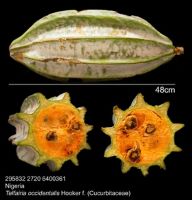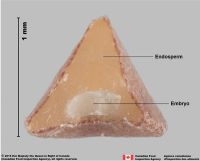Content is from Kirkbride et al. 2006Kirkbride et al. 2006:
Kirkbride JH, Jr, Gunn CR, and Dallwitz MJ. 2006. Family guide for fruits and seeds, vers. 1.0. Accessed September 2020-January 2022. URL: https://nt.ars-grin.gov/seedsfruits/keys/frsdfam/index.cfm ., without modification.
Updates are forthcoming.
Cones: Dry; strobilus when dry (Spjut Fig. 51A-B & only family); globoseglobose:
3D shape—more or less spherical ; symmetrical; with sporophylls; with frondlike sporophylls.
; symmetrical; with sporophylls; with frondlike sporophylls.
Seeds: Arilaril:
(broad sense) appendicular structure that wholly or partly envelops a seed and is produced from or a modification of the funicle, raphe, or outer integument; usually fleshy or pulpy, sometimes spongy or tufted-capillate, often brightly colored absent. Seed larger than minute; 25 to less than 50 mm long to 50+ mm long; 30–60 mm long; ellipsoidellipsoid:
absent. Seed larger than minute; 25 to less than 50 mm long to 50+ mm long; 30–60 mm long; ellipsoidellipsoid:
3D shape—elliptic
, or circularcircular:
(of embryo) linear embryo is curved into an "O" shape ; in transectiontransection:
; in transectiontransection:
a cross section; representing a plane made by cutting across an organ at a right angle to its length tereteterete:
tereteterete:
approximately circular in cross section; width and thickness approximately equal
 ; not bowl shaped; not nutlike; without winglike beakbeak:
; not bowl shaped; not nutlike; without winglike beakbeak:
a usually firm, terminal appendage, sometimes tapered ; without caudatecaudate:
; without caudatecaudate:
tapering to a long, tail-like appendage appendage(s); at maturity with food reserves; with endospermendosperm:
appendage(s); at maturity with food reserves; with endospermendosperm:
nutritive starch- and oil-containing tissue present in many seeds ; without canavanine. Sarcotestasarcotesta:
; without canavanine. Sarcotestasarcotesta:
pulpy or fleshy outer layer of the seed coat, simulates aril absent. Testatesta:
absent. Testatesta:
seed coat
 present; with fleshyfleshy:
present; with fleshyfleshy:
texture—fairly firm and dense, juicy or at least moist, and easily cut
or leatheryleathery:
texture—moderately thick, tough, and very pliable
layer over hard layer (& over corkycorky:
firm, relatively light, discontinuous but strongly cohesive, and resilient
& bouyant layer); tight; dulldull:
reflecting only a low proportion of incident light, with no apparent sheen ; surface smooth, or unsmooth; surface with merged raised features; surface wrinkledwrinkled:
; surface smooth, or unsmooth; surface with merged raised features; surface wrinkledwrinkled:
surface relief—shallow, irregular folds and furrows covering the surface; appearing overall though crumpled and then spread out ; without crease or line separating cotyledons from hypocotyl-radicle; without notch along margin where cotyledons from hypocotyl-radicle tip approach each other; without glands; without bristles; glabrousglabrous:
; without crease or line separating cotyledons from hypocotyl-radicle; without notch along margin where cotyledons from hypocotyl-radicle tip approach each other; without glands; without bristles; glabrousglabrous:
without hairs
; without wings; without collar; without operculumoperculum:
a dehiscent cap (or lid) of a seed or fruit that opens during germination or dehiscence
 ; colored; monochrome; red (dish-brown), or brown (all shades), or yellow, or cream; not becoming mucilaginousmucilaginous:
; colored; monochrome; red (dish-brown), or brown (all shades), or yellow, or cream; not becoming mucilaginousmucilaginous:
resembling mucilage; moist and sticky
when wetted. Endospermendosperm:
nutritive starch- and oil-containing tissue present in many seeds copious, or moderate; opaqueopaque:
copious, or moderate; opaqueopaque:
not transmitting light
; smooth; without fatty acid containing cyclopropene; without apicalapical:
at or pertaining to the end of the seed or fruit distal from its point of attachment (i.e., base)
lobes; without chlorophyll; without isodiametric faceted surface; without odor. Embryo differentiated from food reserve; well developed; 1 per seed; partially filling testatesta:
seed coat
 (with food reserve); 0.7 times the length of food reserve; at one end of seed not extending into a depression or cup; axileaxile:
(with food reserve); 0.7 times the length of food reserve; at one end of seed not extending into a depression or cup; axileaxile:
on or of the axis
and centric; foliatefoliate:
appearing leaf-like
; with more or less spatulatespatulate:
2D shape—like a spatula; rounded at the apex, with base long and tapered; (of embryo) embryo is straight and axile and centric with the cotyledons expanded to form the shape of a spatula or spoon; (of cotyledons) cotyledons expanded and wider than the stalk but not invested into the stalk cotyledons; straight; parallel to seed length; with cotyledons gradually connected to hypocotyl-radicle; without coleorhiza; without simmondsin; without stomata; not green; with 2 or more cotyledons. Cotyledons 2; well developed; 0.3–0.9 times length of embryo; somewhat to significantly wider than hypocotyl-radicle; 1 times wider than hypocotyl-radicle (or a little more); smooth; with apicesapex:
cotyledons; straight; parallel to seed length; with cotyledons gradually connected to hypocotyl-radicle; without coleorhiza; without simmondsin; without stomata; not green; with 2 or more cotyledons. Cotyledons 2; well developed; 0.3–0.9 times length of embryo; somewhat to significantly wider than hypocotyl-radicle; 1 times wider than hypocotyl-radicle (or a little more); smooth; with apicesapex:
the point farthest from the point of attachment, or the "tip" of an organ entire; with margins adhering (usually at tips), or separate; basally entire; unequal in size; not punctatepunctate:
entire; with margins adhering (usually at tips), or separate; basally entire; unequal in size; not punctatepunctate:
surface relief—dotted with pits or with translucent, sunken glands or with colored dots, similar to pitted dotted. Hypocotyl-radicle well developed, or moderately developed; straight; not thickened.
dotted. Hypocotyl-radicle well developed, or moderately developed; straight; not thickened.
Literature specific to this family: Miquel, F.A.W. 1845. Observationes de ovulo et embryonibus Cycadearum. Ann. Sci. Nat., Bot. sér. 3, 3:193–206, tab. 8 & 9.
General references: Engler, A. & K. Prantl. 1924 and onward. Die Natürlichen Pflanzenfamilimien. W. Engelman, Leipzig, Gunn, C.R. & J.V. Dennis. 1976. World guide to tropical drift seeds and fruits, 240 pp. The New York Times Book Co., New York, Gunn, C.R., J.H. Wiersema, C.A. Ritchie, & J.H. Kirkbride, Jr. 1992 & amendments. Families and genera of Spermatophytes recognized by the Agricultural Research Service. Techn. Bull. U.S.D.A. 1796:1–500, LeMaout, E. & J. Decaisne. 1876. A general system of botany, 1,065 p. Longmans, Green, & Co., London, Mabberley, D.J. 1987. The plant-book, 706 p. Cambridge University Press, Cambridge, Spjut, R.W. 1994. A systematic treatment of fruit types. Mem. New York Bot. Gard. 70:1–182, and Johnson, L.A.S. & K.L. Wilson. 1990. Cycadophytina/Cycadatae with the single living order Cycadales (Cycads). In: Kubitzki, K., ed., The families and genera of vascular plants, pp. 362–377. Springer-Verlag, Berlin.